Key takeaways:
- Flexibility is crucial in breakdancing for executing complex moves, preventing injuries, and enhancing artistic expression.
- Incorporating both dynamic and static stretches into practice routines improves flexibility and overall performance.
- Maintaining flexibility involves consistent warm-ups, holding stretches longer, and integrating yoga for mental and physical benefits.
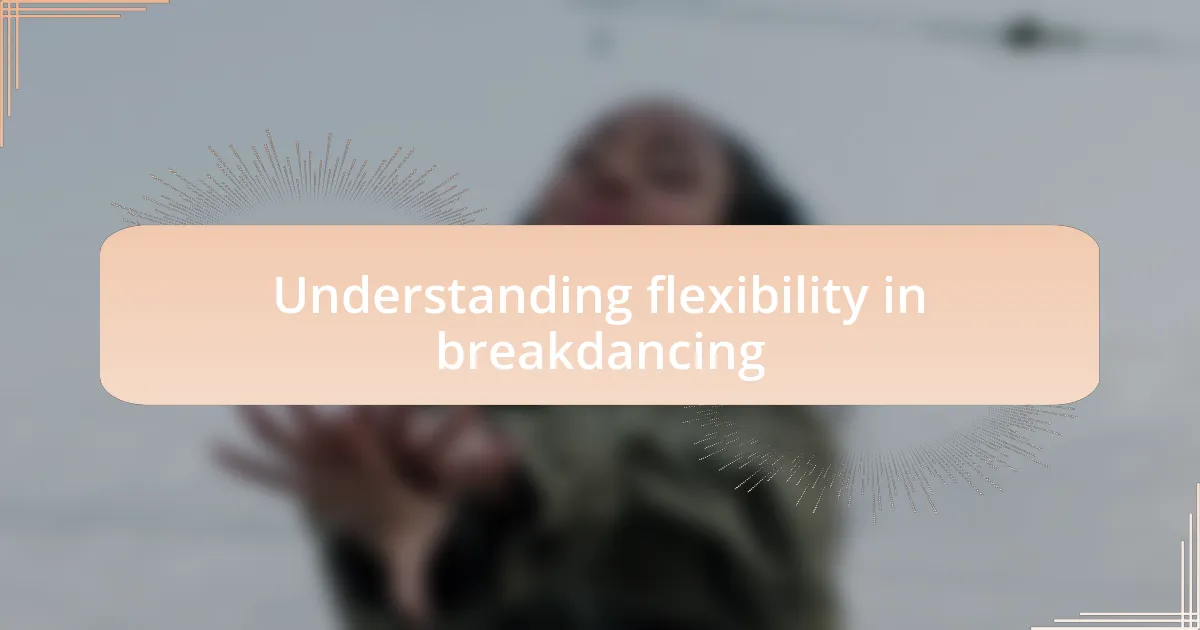
Understanding flexibility in breakdancing
Flexibility in breakdancing is not just about being able to perform impressive moves; it’s about feeling the rhythm of your body and how it flows. I remember the first time I really noticed the connection between flexibility and my dance moves; I landed an inverted freeze perfectly after weeks of stretching. That moment was exhilarating and showed me just how critical flexibility is for both aesthetics and injury prevention.
When I see incredible b-boys and b-girls glide through their routines with such grace, it often leaves me wondering: how do they maintain such control over their bodies? Flexibility allows for a wide range of motion, which is essential for executing complex footwork and power moves. Without it, you might find yourself struggling to hit those crucial transitions smoothly.
Moreover, flexibility plays a vital role in preventing injuries, something every dancer should prioritize. I once faced a setback with a hamstring injury due to neglecting my stretch routine, and it taught me a vital lesson. Each stretch, no matter how small, is a step towards not just improving your skills but also ensuring that you can keep dancing for years to come.
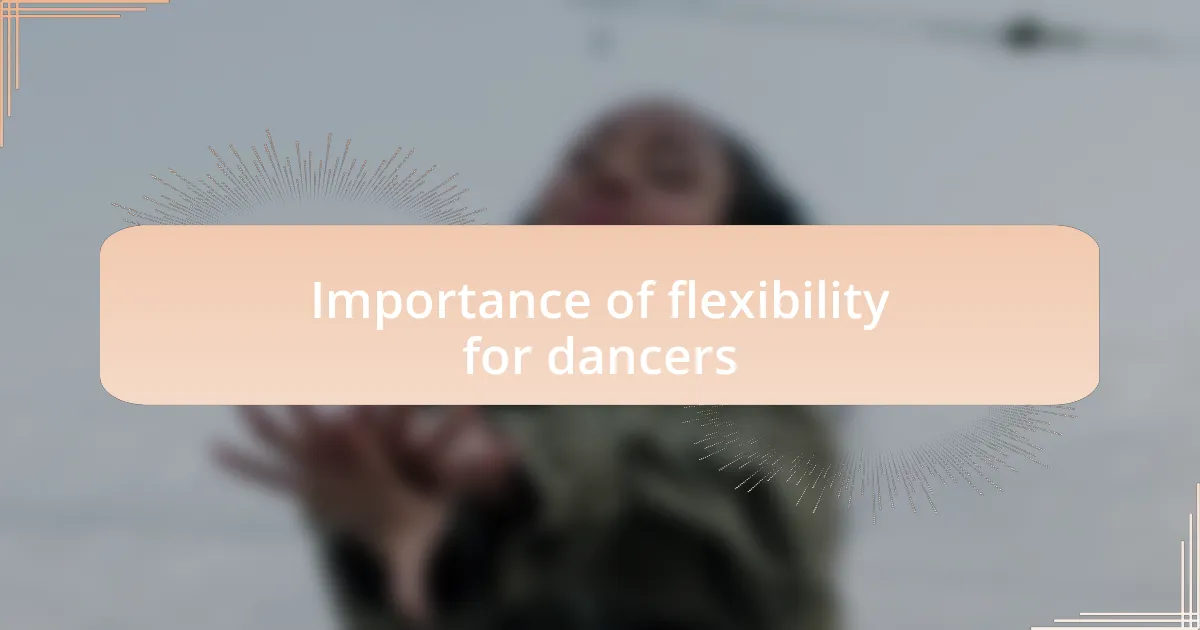
Importance of flexibility for dancers
Flexibility is often the unsung hero of a dancer’s routine. Reflecting on my own journey, there were times when a lack of flexibility led to unnecessary frustration during practice. I vividly remember struggling through a session where my body just wouldn’t cooperate, making me realize how essential that elastic quality is for not only executing moves but truly expressing myself on the dance floor.
When I observe fellow dancers mastering intricate routines, I often find myself thinking about how their flexibility enhances their artistry. It’s not just about the technical aspects; it’s also about how flexible dancers can communicate emotion and style through their movements. I once witnessed a b-girl effortlessly transition from a power move to a fluid floor combination, and it struck me that her flexibility was the bridge between the two worlds of strength and grace.
Moreover, flexibility allows for a deeper connection between the mind and body. I’ve experienced moments where feeling loose and limber brought an incredible sense of freedom in my movements, almost as if I was floating. Have you ever felt that? It’s in these moments that you truly understand the beauty of dance—how each stretch and contraction tells a story and how being flexible transforms not only your performance but your whole dancing experience.
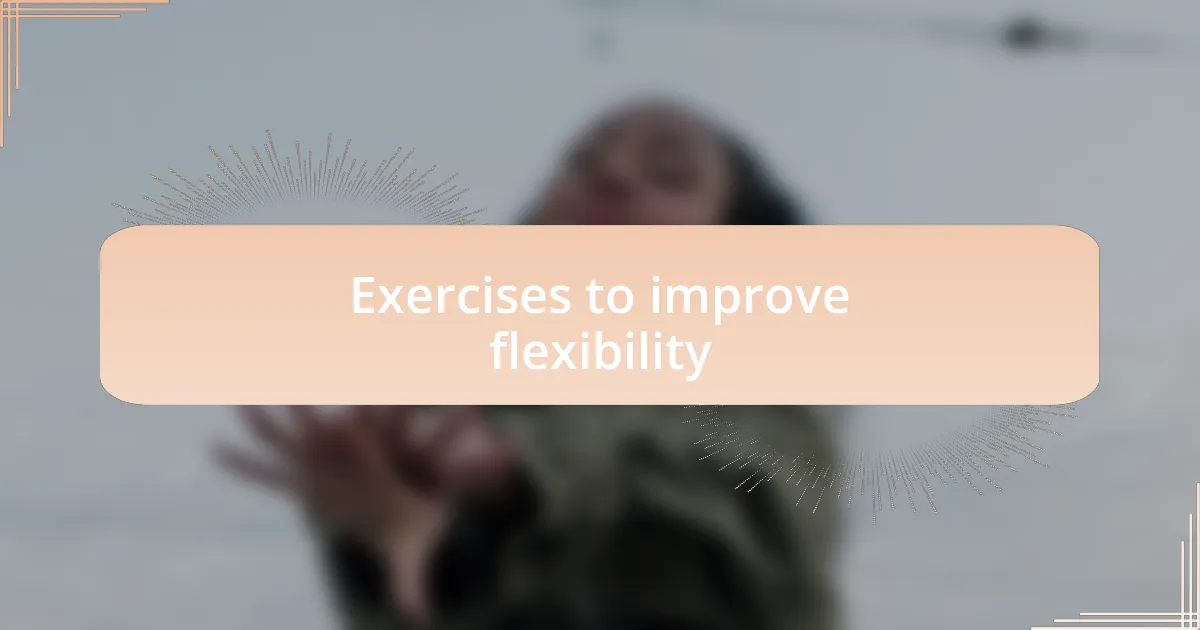
Exercises to improve flexibility
Incorporating dynamic stretches into your routine is an excellent way to enhance flexibility. I’ve found that movements like leg swings and hip circles prepare my body for those demanding breakdancing sessions. Have you ever noticed how much easier it feels to hit those tricky poses after a good warm-up? I can assure you that taking the time to engage in these exercises pays off.
I also recommend incorporating static stretches at the end of your practice. As I cool down, I often include stretches like the butterfly stretch and the pigeon pose. These stretches help to elongate my muscles after a hard-hitting session, allowing me to recover better and feel more limber the next day. Do you ever feel that satisfying release as you sink deeper into a stretch? It’s one of my favorite parts of the routine.
Proprioceptive neuromuscular facilitation (PNF) stretching is another technique that has dramatically improved my flexibility. In my experience, using this method, where you contract and then relax the muscle you’re stretching, can lead to greater gains in flexibility. I remember when my stretching partner and I worked on our splits using PNF. It was challenging, but the progress we made was motivating. Have you tried this technique yet? If not, I encourage you to give it a shot; you’ll notice the difference.
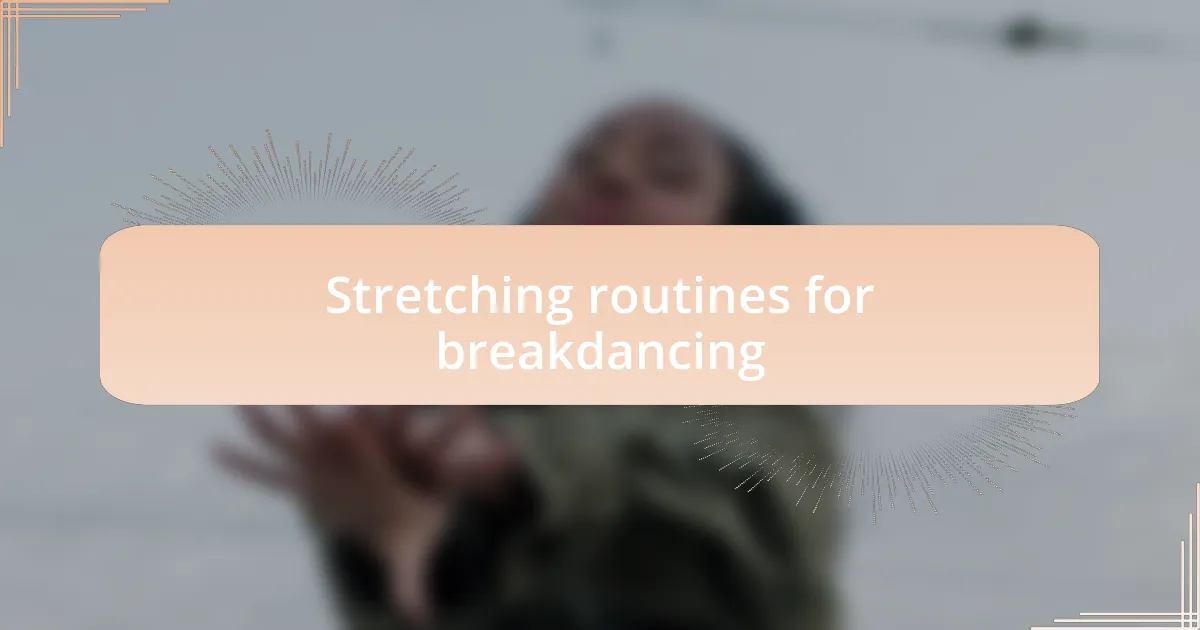
Stretching routines for breakdancing
When I think about stretching routines for breakdancing, my mind goes straight to routine consistency. One favorite exercise of mine is the wall-assisted split stretch. It really helped me improve my straddle flexibility, which is key for many dance moves. Does it feel like you’re making progress with each stretch? Trust me, it does—especially when you can finally hold that split for longer!
Another valuable part of my routine is dynamic stretching with a twist. I like to incorporate lunges with a torso twist. This not only hits my hip flexors but also warms up my spine. It always surprises me how energized I feel after this move. Can you relate? Each time I complete this sequence, it feels like I’m unlocking new ranges of motion in my dance.
Lastly, I can’t stress enough the importance of a recovery-focused stretch routine. After an intense practice, I sink into a deep lunge stretch, which opens the hips and feels incredible after all the twisting and turning. It may seem simple, but taking those moments to breathe and feel grounded is essential. Have you ever noticed how these cool-down stretches can elevate your overall flexibility game? Embracing this part of my routine has truly transformed my dance experience.
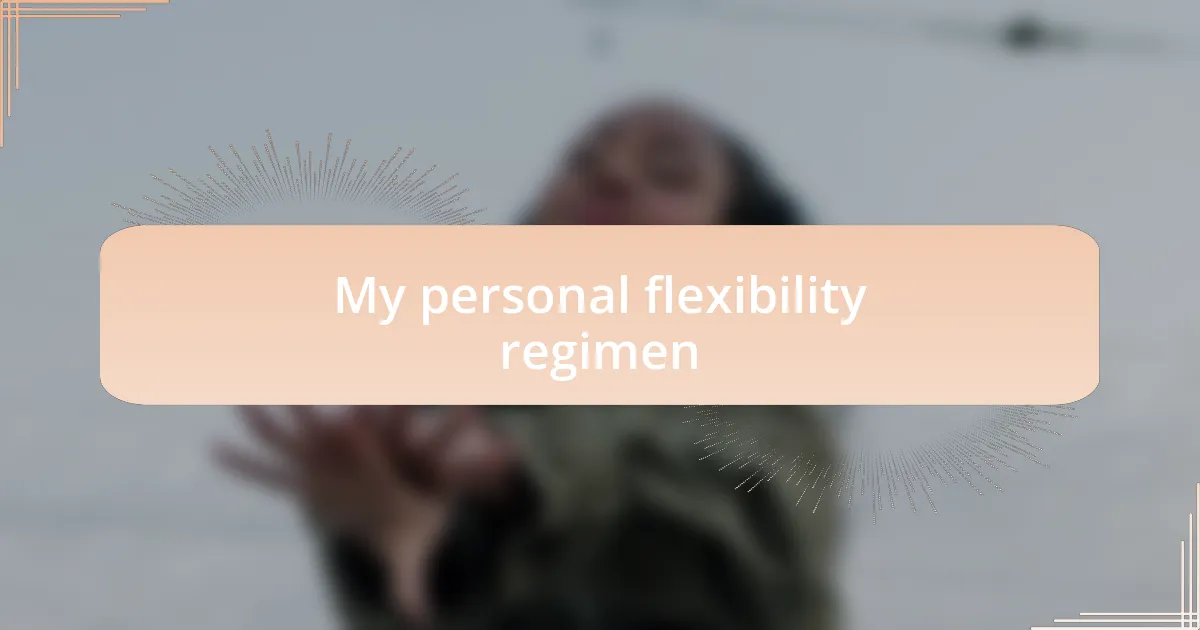
My personal flexibility regimen
In my personal flexibility regimen, I prioritize a mix of static and dynamic stretches tailored to my breakdancing needs. One of my go-to moves is the seated forward bend; when I reach towards my toes, I can literally feel the tension melting away from my hamstrings. Have you ever noticed how a simple stretch can shift your whole mood? For me, this stretch not only improves flexibility but also clears my mind, allowing me to focus better on my dance.
Another integral part of my routine is the butterfly stretch, which I practice regularly. I remember the first time I managed to sit with my feet pressed together and my knees flat on the ground—what a victory that was! That moment reaffirmed my belief in the power of persistence. Each time I stretch in this position, it feels like I’m also opening up my heart to new dance possibilities.
I also dedicate some time to foam rolling, which has become essential in my regimen. There was a period when I ignored my muscles’ needs; I quickly learned that neglecting recovery rituals only hinders my flexibility. The feeling of releasing tight spots, especially after a long practice session, is incredibly rewarding. Have you ever experienced that blend of discomfort and relief? It’s like finally giving my body the love it deserves, enhancing both my flexibility and overall performance.
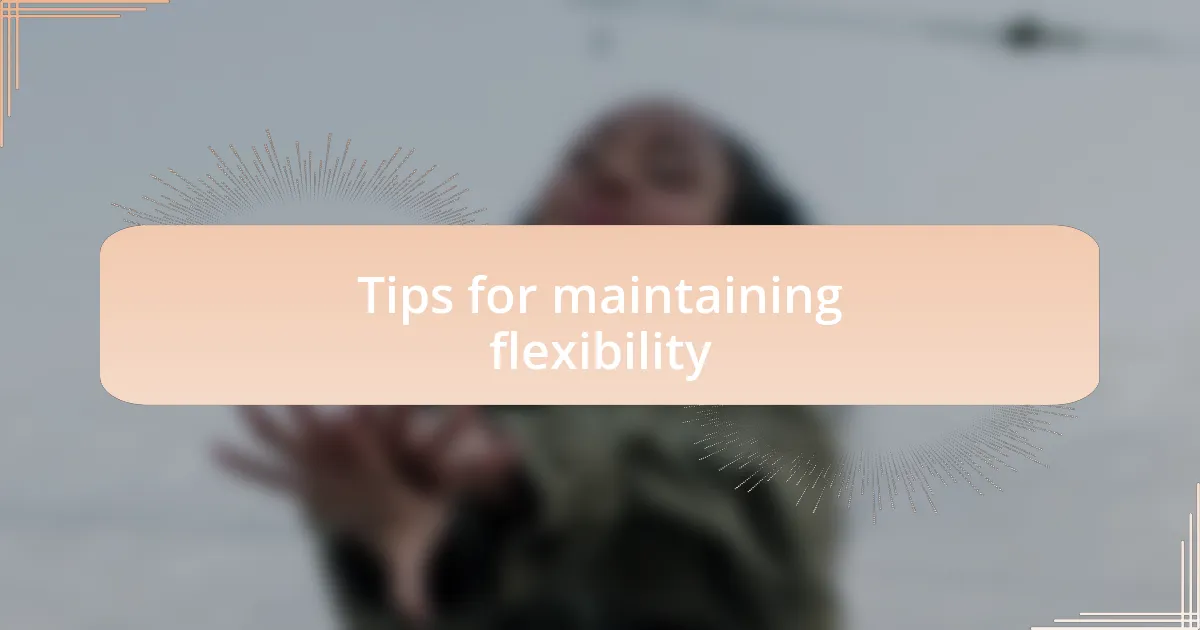
Tips for maintaining flexibility
To maintain flexibility, I’ve found that incorporating routine warm-ups is crucial. Before diving into any intense practice, I spend about 10 minutes on light cardio, like jumping jacks and jogging in place. This elevates my heart rate and prepares my muscles for stretching, ensuring I get the most out of each movement. Have you ever noticed how easier stretching feels after warming up? It’s like your body is saying, “Thank you for taking the time!”
Another technique that has proven effective is holding stretches for longer durations. When I hold a stretch for at least 30 seconds, I can almost feel my muscles gradually releasing tension. I recall a moment when I struggled to hit a particular split, and it was that extra time spent stretching that finally unlocked my potential. The patience required in this process resonates deeply with me; it’s a reminder that progress takes time, and each session is a step toward mastery.
Don’t underestimate the power of integrating yoga into your flexibility routine. I remember the first time I attended a yoga class specifically designed for dancers. The fluidity of the movements alongside the deep breathing techniques brought an unexpected sense of tranquility. It felt like I was not only stretching my body but also my mind. Have you ever thought about how yoga can enhance both your physical and mental flexibility? The balance I’ve gained from those sessions significantly complements my breakdancing, creating harmony between body and mind.